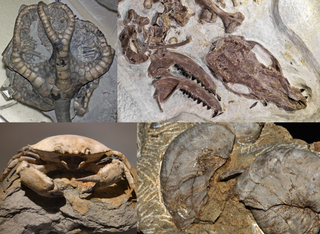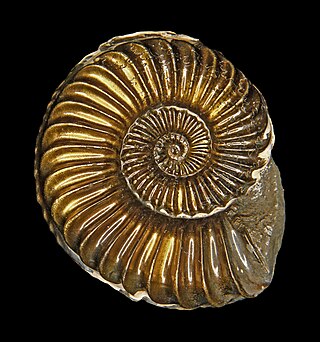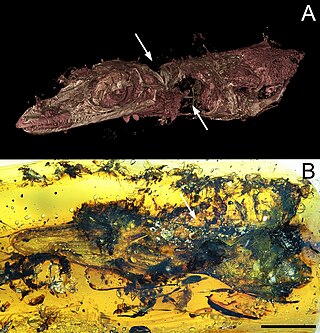
Amber is fossilized tree resin that has been appreciated for its color and natural beauty since Neolithic times. Much valued from antiquity to the present as a gemstone, amber is made into a variety of decorative objects. Amber is used in jewelry and has been used as a healing agent in folk medicine.

A fossil is any preserved remains, impression, or trace of any once-living thing from a past geological age. Examples include bones, shells, exoskeletons, stone imprints of animals or microbes, objects preserved in amber, hair, petrified wood and DNA remnants. The totality of fossils is known as the fossil record.

Ammonoids are a group of extinct marine mollusc animals in the subclass Ammonoidea of the class Cephalopoda. These molluscs, commonly referred to as ammonites, are more closely related to living coleoids than they are to shelled nautiloids such as the living Nautilus species. The earliest ammonites appeared during the Devonian, with the last species vanishing during or soon after the Cretaceous–Paleogene extinction event.

Oviraptoridae is a group of bird-like, herbivorous and omnivorous maniraptoran dinosaurs. Oviraptorids are characterized by their toothless, parrot-like beaks and, in some cases, elaborate crests. They were generally small, measuring between one and two metres long in most cases, though some possible oviraptorids were enormous. Oviraptorids are currently known only from the Late Cretaceous of Asia, with the most well-known species and complete specimens found only in the Gobi Desert of Mongolia and northwestern China.

Dipterocarpaceae is a family of 16 genera and about 695 known species of mainly tropical lowland rainforest trees. The family name, from the type genus Dipterocarpus, is derived from Greek and refers to the two-winged fruit. The largest genera are Shorea, Hopea, Dipterocarpus, and Vatica. Many are large forest-emergent species, typically reaching heights of 40–70 m, some even over 80 m, with the tallest known living specimen 93.0 m tall. The species of this family are of major importance in the timber trade. Their distribution is pantropical, from northern South America to Africa, the Seychelles, India, Indochina, Indonesia, Malaysia and Philippines. The greatest diversity of Dipterocarpaceae occurs in Borneo. Some species are now endangered as a result of overcutting, extensive illegal logging, and habitat conversion. They provide valuable woods, aromatic essential oils, balsam, and resins, and are a source for plywood.

The Enantiornithes, also known as enantiornithines or enantiornitheans in literature, are a group of extinct avialans, the most abundant and diverse group known from the Mesozoic era. Almost all retained teeth and clawed fingers on each wing, but otherwise looked much like modern birds externally. Over eighty species of Enantiornithes have been named, but some names represent only single bones, so it is likely that not all are valid. The Enantiornithes became extinct at the Cretaceous–Paleogene boundary, along with Hesperornithes and all other non-avian dinosaurs.

Repenomamus is a genus of opossum- to badger-sized gobiconodontid mammal containing two species, Repenomamus robustus and Repenomamus giganticus. Both species are known from fossils found in China that date to the early Cretaceous period, about 125-123.2 million years ago. R. robustus is one of several Mesozoic mammals for which there is good evidence that it fed on vertebrates, including dinosaurs. Though it is not entirely clear whether or not these animals primarily hunted live dinosaurs or scavenged dead ones, evidence for the former is present in fossilized remains showcasing the results of what was most likely a predation attempt by R. robustus directed at a specimen of the dinosaur Psittacosaurus lujiatunensis. R. giganticus is among the largest mammals known from the Mesozoic era.

Dunkleosteus is an extinct genus of large arthrodire ("jointed-neck") fish that existed during the Late Devonian period, about 382–358 million years ago. It was a pelagic fish inhabiting open waters, and one of the first apex predators of any ecosystem.

Symplocos is a genus of flowering plants in the order Ericales. It contains about 300 species distributed in Asia and the Americas. Many species grow in humid tropical regions. This is sometimes considered to be the only genus in family Symplocaceae. Plants in this family are shrubs and trees with white or yellow flowers. The oldest fossils of the genus date to the lower Eocene of Europe and North America, with the genus being present in Europe as late as the Pliocene. Fossil seeds of †Symplocos granulosa are frequent in sediment rock layers of the Late Oligocene to the Late Miocene of Denmark, Germany, Austria and Poland. The fossil seeds are very similar to the seeds of the extan southern Chinese species Symplocos glandulifera and Symplocos sulcata. Fossil seeds of †Symplocos paucicostata are known from the Middle Pliocene sediment rock layers in Reuver, the Netherlands and from the Late Pliocene sediment rock layers in northern Italy. The fossil seeds are very similar to the seeds of the extant East Asian species Symplocos paniculata

Megarachne is a genus of eurypterid, an extinct group of aquatic arthropods. Fossils of Megarachne have been discovered in deposits of Late Carboniferous age, from the Gzhelian stage, in the Bajo de Véliz Formation of San Luis, Argentina. The fossils of the single and type species M. servinei have been recovered from deposits that had once been a freshwater environment. The generic name, composed of the Ancient Greek μέγας (megas) meaning "great" and Ancient Greek ἀράχνη (arachne) meaning "spider", translates to "great spider", because the fossil was misidentified as a large prehistoric spider.
Gum copal is a resin produced by the sap of forest tree in the genus Daniellia. Due to common impurities and differences in regions, gum copal ranges in color from black to yellow to white. Gum copal, along with ivory and slaves, was a significant export from East Africa in the 19th century. It can have an appearance similar to amber and may be mistaken for it. Unlike amber, gum copal is usually only 100–1,000 years old and it has not yet fossilized.
Roystonea palaea is an extinct species of palm known from fossil flowers found in the early Miocene Burdigalian stage Dominican amber deposits on the island of Hispaniola. The species is known from a single staminate flower and a single pistillate flower both preserved in the same piece of amber. The amber specimen bearing the holotype and paratype is currently deposited in the collections of the Oregon State University in Corvallis, Oregon, as number "Sd–9–101", where it was studied and described by George Poinar. Poinar published his 2002 type description for R. palaea in the Botanical Journal of the Linnean Society, Volume 139. The species' second name is taken from the Greek word palaios meaning "ancient". The amber specimen bearing the flowers was excavated from the La Toca mine northeast of Santiago de los Caballeros, Dominican Republic.

Mongolarachne is an extinct genus of spiders placed in the monogeneric family Mongolarachnidae. The genus contains only one species, Mongolarachne jurassica, described in 2013, which is presently the largest fossilized spider on record. The type species was originally described as Nephila jurassica and placed in the living genus Nephila which contains the golden silk orb-weavers.

Dinosaur coloration is generally one of the unknowns in the field of paleontology, as skin pigmentation is nearly always lost during the fossilization process. However, recent studies of feathered dinosaurs and skin impressions have shown the colour of some species can be inferred through the use of melanosomes, the colour-determining pigments within the feathers.

Vetufebrus is an extinct genus of haemospororida in the family Plasmodiidae. At the time of its description the new genus comprised a single species Vetufebrus ovatus known from a single Miocene Dominican amber fossil found on Hispaniola. V. ovatus was vectored by Enischnomyia stegosoma, the first fossil streblid bat fly described from a fossil, and the only member of the subfamily Nycterophiliinae described from Hispaniola. V. ovatus is the first instance of a Streblidae bat fly as a host for a malarial parasite.

Manipulator modificaputis is an extinct cockroach which lived during the Upper Cretaceous period. The holotype specimen is fossilized in a 100-million-year-old piece of Burmese amber, which was found in a quarry of volcanoclastic mudstone at Noije Bum in the Hukawng Valley in Myanmar. The insect has been described by Peter Vršanský, of the Geological Institute SAS of Bratislava, and by Günter Bechly, of the Staatliches Museum für Naturkunde in Stuttgart.

Burmese amber, also known as Burmite or Kachin amber, is amber from the Hukawng Valley in northern Myanmar. The amber is dated to around 100 million years ago, during the latest Albian to earliest Cenomanian ages of the mid-Cretaceous period. The amber is of significant palaeontological interest due to the diversity of flora and fauna contained as inclusions, particularly arthropods including insects and arachnids but also birds, lizards, snakes, frogs and fragmentary dinosaur remains. The amber has been known and commercially exploited since the first century AD, and has been known to science since the mid-nineteenth century. Research on the deposit has attracted controversy due to its alleged role in funding internal conflict in Myanmar and hazardous working conditions in the mines where it is collected.

Borealopelta is a genus of nodosaurid ankylosaur from the Lower Cretaceous of Alberta, Canada. It contains a single species, B. markmitchelli, named in 2017 by Caleb Brown and colleagues from a well-preserved specimen known as the Suncor nodosaur. Discovered at an oil sands mine north of Fort McMurray, Alberta, the specimen is remarkable for being among the best-preserved dinosaur fossils of its size ever found. It preserved not only the armor (osteoderms) in their life positions, but also remains of their keratin sheaths, overlying skin, and stomach contents from the animal's last meal. Melanosomes were also found that indicate the animal had a reddish skin tone.

Oculudentavis is an extinct genus of lizard of uncertain taxonomic placement, originally identified as an avialan dinosaur. It contains two known species, O. khaungraae and O. naga. Each species is known from one partial fossil specimen in Burmese amber, which differ in several proportions. Their skulls measure 1.4–1.7 centimetres (0.55–0.67 in) in length, indicating that Oculudentavis would have been comparable in size with the modern bee hummingbird if it were an avialan. Both specimens were retrieved from 99-million-year-old deposits of the Hukawng Basin in Kachin State, northern Myanmar. The type specimen of O. khaungraae is embroiled in controversy regarding its identity and the ethical issues surrounding the acquisition and study of Burmese amber. The original description advocating for an avialan identity was published in Nature, but has since then been retracted from the journal.

Triamyxa is an extinct genus of myxophagan beetle in the monotypic family Triamyxidae from the Carnian stage of Late Triassic, approximately 230 million years ago. It was found in the Keuper Claystone of Poland. The type species is T. coprolithica and it was identified from specimens found in the coprolite ZPAL AbIII/3520, likely belonging to the dinosauriform Silesaurus opolensis. Because Triamyxa specimens were found inside coprolites, this may offer a new method of finding insect fossils aside from amber. It is currently the oldest known member of Myxophaga. It was interpreted as either the most basal member of Myxophaga, or a sister group to Hydroscaphidae.


















